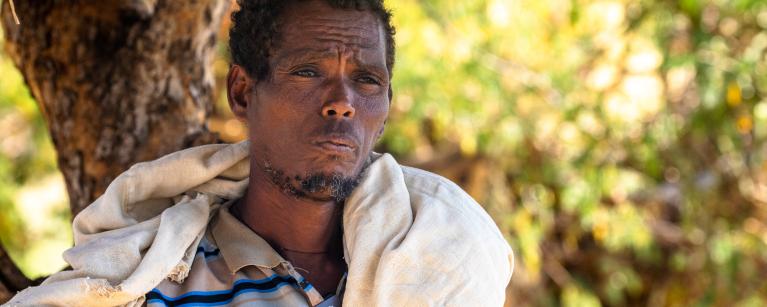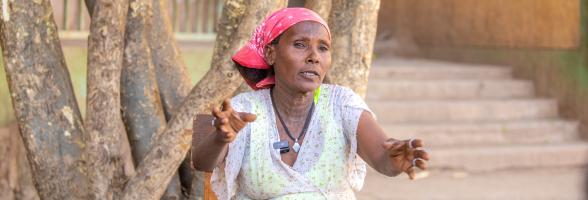Gebrezgabiher Habtu, is busy clearing his land in preparation for yet another attempt at farming. With only a handful of onion, tomato, and sorghum seeds he has left, Gebrezgabiher remains hopeful that the rain would come this time round, and he would be able to cultivate something so he can provide for his children.
“I hope that God will send rain to us. We have not seen even a drop of rain in the last five years but that does not mean we give up. I come to the farm, do the little I can do, and then I go look for menial jobs such as cleaning which will at least help feed my family” explains Gebrezgabiher, a father of six and a farmer from Fia village in Tigray, Northern Ethiopia.
Despite the absence of rainfall, Gebrezgabiher and his community walk long distances during drought to fetch water which they can use at the farm but his is far from sufficient due to the challenges of accessing water in Tigray.
“Even with the challenges of accessing the water, the crops wither and die, leaving them unsuitable even for livestock feed,” says Gebrezgabiher as he explains the stark reminder of the toll drought has taken on their lives and livelihoods.
Ongoing Crisis: Tigray's Battle with Drought
In Tigray, the drought has ravaged 36 districts across five zones, causing extensive damage to crop, pasture, and water sources for livestock. Out of 1.3 million hectares of arable land, only 49 percent was planted due to drought and accessibility issues, with a mere 37 percent of production harvested during the Meher season (May to September).
Recently the Tigray Disaster and Risk Management Commission reported that approximately 2.2 million people, in Tigray have been affected by the drought. On the other hand, the interim administration of Tigray believes that a higher number, around 4.2 million people, including internally displaced persons (IDPs) are facing the consequences of this crisis.
"We expected some rain in August which would have helped a little bit, but we have not seen any rain, it's now December," Gebrezgabiher explains. He now works menial jobs at the interim government offices so he is able to get a bit of money to help feed his children.
OXFAM has been providing vital support to communities in Tigray by providing emergency food aid, water, and cash to those most affected. However, the assistance is far outweighing the needs of the communities in Tigray.
As of January 2024, nearly 1.4 million people in Tigray urgently require emergency food due to the drought. Additionally, close to a million internally displaced persons (IDPs) in Tigray rely on humanitarian aid for survival.
The call for support echoes through the landscapes of Fia Kebele—a plea for sustenance and hope amidst the harsh realities of drought. Gebrezgabiher passionately urges, "What we urgently require at this point is food and water” he says adding that he will continue looking after his farm as he does other jobs that would be able to help sustain for his family.

